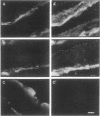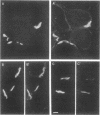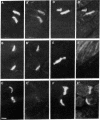Abstract
Highly purified cholinergic postsynaptic membranes from Torpedo electric tissue contain, in addition to the acetylcholine receptor (AcChoR), major proteins of Mr 43,000 and Mr approximately 90,000 and minor proteins that can be removed from the membranes by alkaline treatment. We have prepared an antiserum to these alkaline-extractable proteins that reacts with the Mr 43,000 protein but not with any of the other major membrane proteins, including the AcChoR subunits. Immunofluorescent staining of sections of Torpedo electric tissue shows that this antiserum binds to the innervated but not the uninnervated surface of the electrocytes. In rat diaphragm muscle, the antigens recognized by this antiserum are highly concentrated at the synapse. Synaptic staining of muscle is eliminated by prior incubation of the antiserum with the Mr 43,000 protein but not by incubation with affinity-purified AcChoR. This antiserum stains end plates of muscles denervated for 7 days. Antiserum to AcChoR binds to the subsynaptic membranes of electrocytes and muscle but does not react with the Mr 43,000 protein. Purified AcChoR blocks staining of synapses by anti-AcChoR but the Mr 43,000 protein does not. These results indicate that the Mr 43,000 protein is located in the innervated membrane of Torpedo electrocytes and that an immunologically similar component is highly concentrated in the postsynaptic membrane of mammalian muscle.
Full text
PDF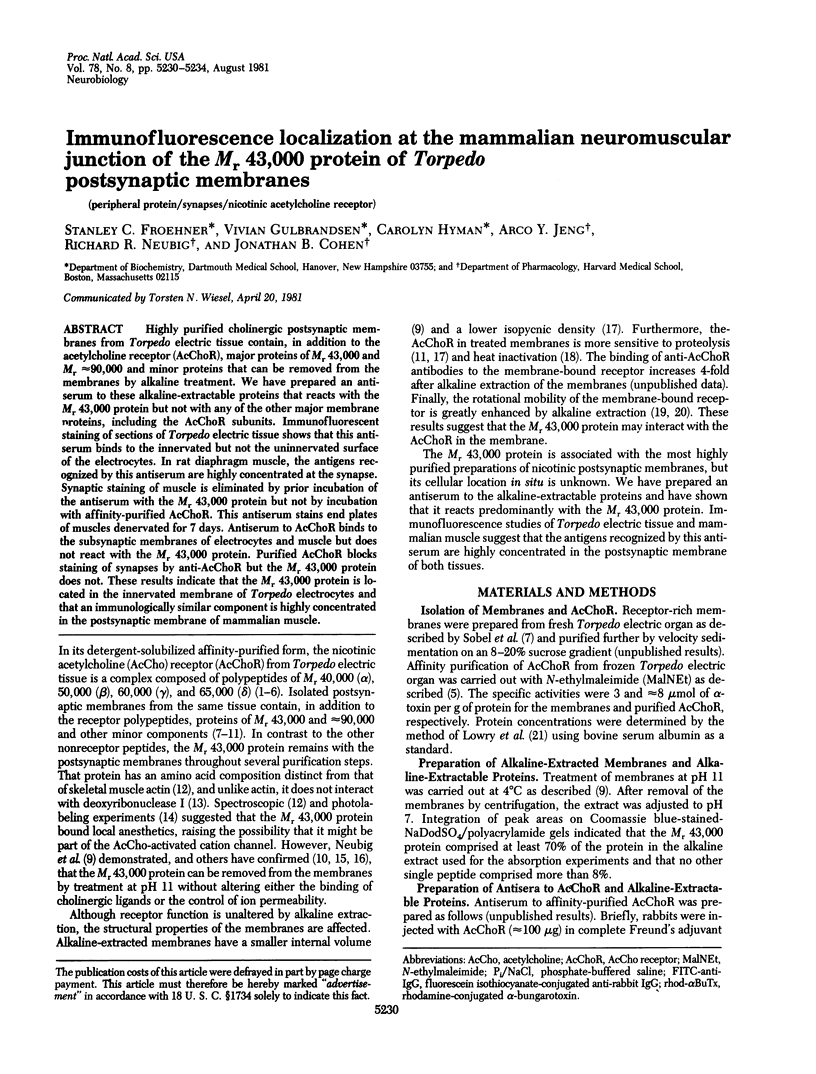
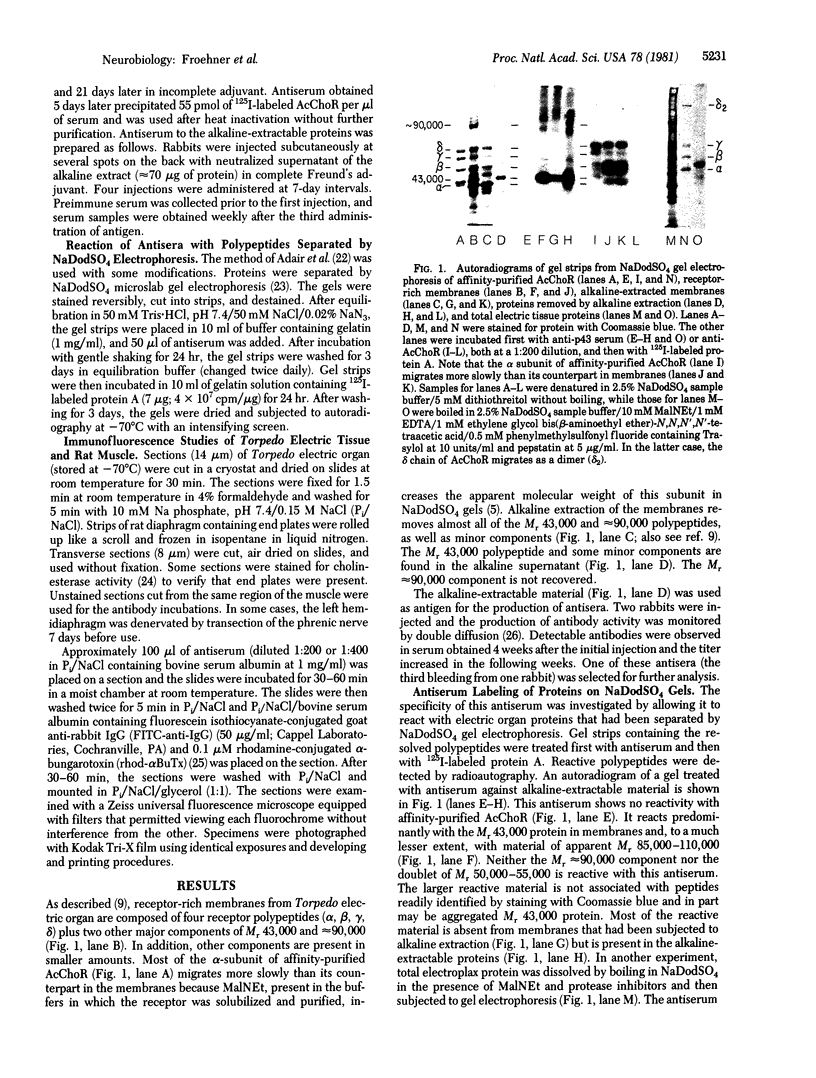
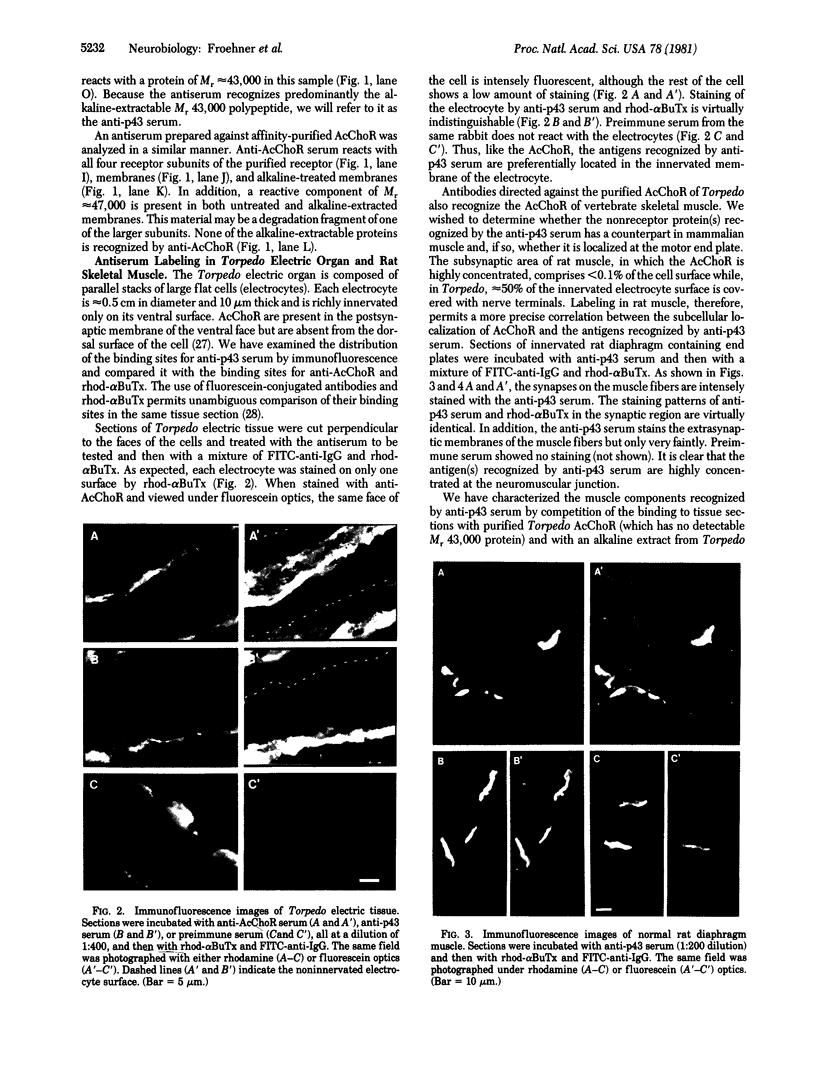
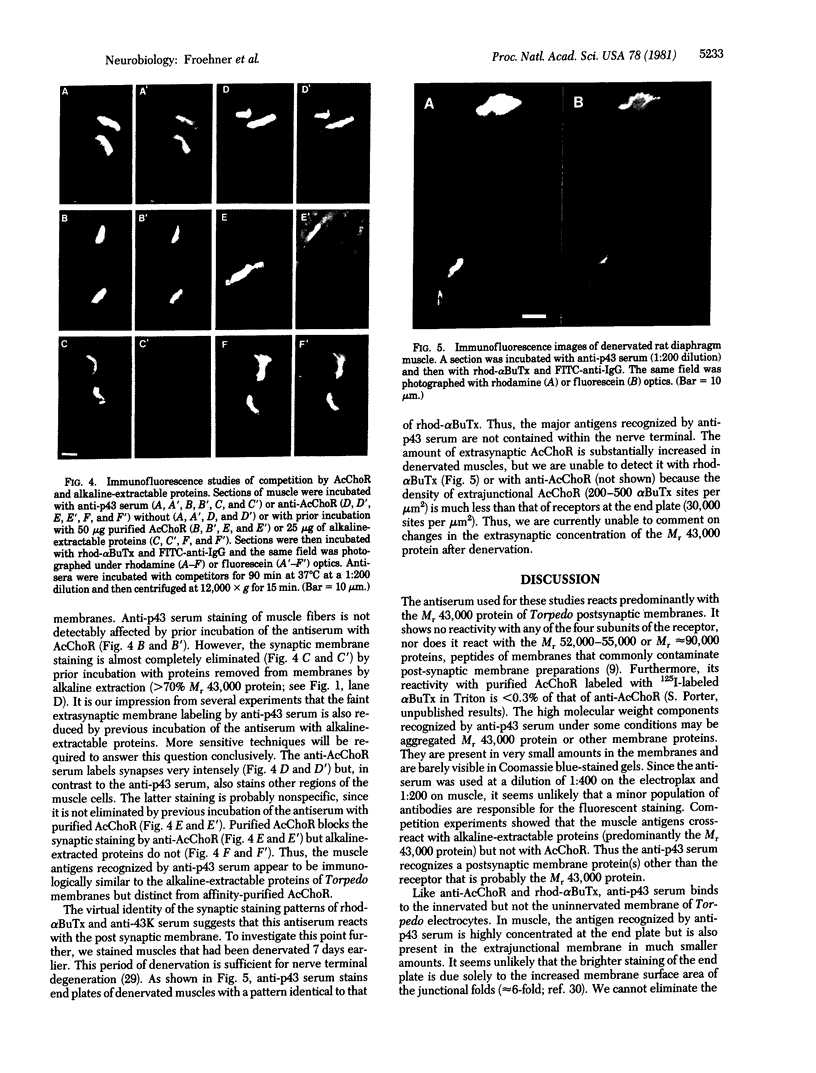
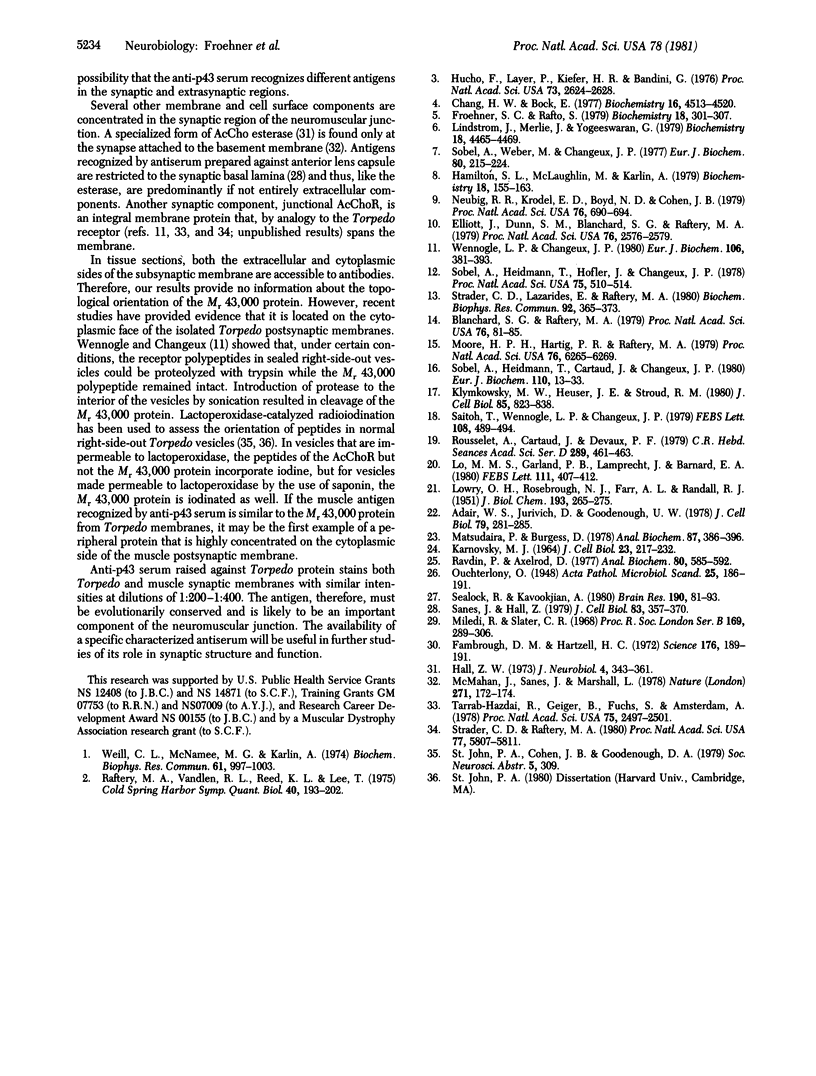
Images in this article
Selected References
These references are in PubMed. This may not be the complete list of references from this article.
- Adair W. S., Jurivich D., Goodenough U. W. Localization of cellular antigens in sodium dodecyl sulfate-polyacrylamide gels. J Cell Biol. 1978 Oct;79(1):281–285. doi: 10.1083/jcb.79.1.281. [DOI] [PMC free article] [PubMed] [Google Scholar]
- Blanchard S. G., Raftery M. A. Identification of the polypeptide chains in Torpedo californica electroplax membranes that interact with a local anesthetic analog. Proc Natl Acad Sci U S A. 1979 Jan;76(1):81–85. doi: 10.1073/pnas.76.1.81. [DOI] [PMC free article] [PubMed] [Google Scholar]
- Chang H. W., Bock E. Molecular forms of acetylcholine receptor. Effects of calcium ions and a sulfhydryl reagent on the occurrence of oligomers. Biochemistry. 1977 Oct 4;16(20):4513–4520. doi: 10.1021/bi00639a028. [DOI] [PubMed] [Google Scholar]
- Elliott J., Dunn S. M., Blanchard S. G., Raftery M. A. Specific binding of perhydrohistrionicotoxin to Torpedo acetylcholine receptor. Proc Natl Acad Sci U S A. 1979 Jun;76(6):2576–2579. doi: 10.1073/pnas.76.6.2576. [DOI] [PMC free article] [PubMed] [Google Scholar]
- Fambrough D. M., Hartzell H. C. Acetylcholine receptors: number and distribution at neuromuscular junctions in rat diaphragm. Science. 1972 Apr 14;176(4031):189–191. doi: 10.1126/science.176.4031.189. [DOI] [PubMed] [Google Scholar]
- Froehner S. C., Rafto S. Comparison of the subunits of Torpedo californica acetylcholine receptor by peptide mapping. Biochemistry. 1979 Jan 23;18(2):301–307. doi: 10.1021/bi00569a011. [DOI] [PubMed] [Google Scholar]
- Hall Z. W. Multiple forms of acetylcholinesterase and their distribution in endplate and non-endplate regions of rat diaphragm muscle. J Neurobiol. 1973;4(4):343–361. doi: 10.1002/neu.480040404. [DOI] [PubMed] [Google Scholar]
- Hamilton S. L., McLaughlin M., Karlin A. Formation of disulfide-linked oligomers of acetylcholine receptor in membrane from torpedo electric tissue. Biochemistry. 1979 Jan 9;18(1):155–163. doi: 10.1021/bi00568a024. [DOI] [PubMed] [Google Scholar]
- Hucho F., Layer P., Kiefer H. R., Bandini G. Photoaffinity labeling and quaternary structure of the acetylcholine receptor from Torpedo californica. Proc Natl Acad Sci U S A. 1976 Aug;73(8):2624–2628. doi: 10.1073/pnas.73.8.2624. [DOI] [PMC free article] [PubMed] [Google Scholar]
- KARNOVSKY M. J. THE LOCALIZATION OF CHOLINESTERASE ACTIVITY IN RAT CARDIAC MUSCLE BY ELECTRON MICROSCOPY. J Cell Biol. 1964 Nov;23:217–232. doi: 10.1083/jcb.23.2.217. [DOI] [PMC free article] [PubMed] [Google Scholar]
- Klymkowsky M. W., Heuser J. E., Stroud R. M. Protease effects on the structure of acetylcholine receptor membranes from Torpedo californica. J Cell Biol. 1980 Jun;85(3):823–838. doi: 10.1083/jcb.85.3.823. [DOI] [PMC free article] [PubMed] [Google Scholar]
- LOWRY O. H., ROSEBROUGH N. J., FARR A. L., RANDALL R. J. Protein measurement with the Folin phenol reagent. J Biol Chem. 1951 Nov;193(1):265–275. [PubMed] [Google Scholar]
- Lindstrom J., Merlie J., Yogeeswaran G. Biochemical properties of acteylcholine receptor subunits from Torpedo californica. Biochemistry. 1979 Oct 16;18(21):4465–4470. doi: 10.1021/bi00588a003. [DOI] [PubMed] [Google Scholar]
- Lo M. M., Garland P. B., Lamprecht J., Barnard E. A. Rotational mobility of the membrane-bound acetylcholine receptor of Torpedo electric organ measured by phosphorescence depolarisation. FEBS Lett. 1980 Mar 10;111(2):407–412. doi: 10.1016/0014-5793(80)80838-6. [DOI] [PubMed] [Google Scholar]
- Matsudaira P. T., Burgess D. R. SDS microslab linear gradient polyacrylamide gel electrophoresis. Anal Biochem. 1978 Jul 1;87(2):386–396. doi: 10.1016/0003-2697(78)90688-7. [DOI] [PubMed] [Google Scholar]
- McMahan U. J., Sanes J. R., Marshall L. M. Cholinesterase is associated with the basal lamina at the neuromuscular junction. Nature. 1978 Jan 12;271(5641):172–174. doi: 10.1038/271172a0. [DOI] [PubMed] [Google Scholar]
- Miledi R., Slater C. R. Electrophysiology and electron-microscopy of rat neuromuscular junctions after nerve degeneration. Proc R Soc Lond B Biol Sci. 1968 Feb 27;169(1016):289–306. doi: 10.1098/rspb.1968.0012. [DOI] [PubMed] [Google Scholar]
- Moore H. P., Hartig P. R., Raftery M. A. Correlation of polypeptide composition with functional events in acetylcholine receptor-enriched membranes from Torpedo californica. Proc Natl Acad Sci U S A. 1979 Dec;76(12):6265–6269. doi: 10.1073/pnas.76.12.6265. [DOI] [PMC free article] [PubMed] [Google Scholar]
- Neubig R. R., Krodel E. K., Boyd N. D., Cohen J. B. Acetylcholine and local anesthetic binding to Torpedo nicotinic postsynaptic membranes after removal of nonreceptor peptides. Proc Natl Acad Sci U S A. 1979 Feb;76(2):690–694. doi: 10.1073/pnas.76.2.690. [DOI] [PMC free article] [PubMed] [Google Scholar]
- Raftery M. A., Vandlen R. L., Reed K. L., Lee T. Characterization of Torpedo californica acetylcholine receptor: its subunit composition and ligand-binding properties. Cold Spring Harb Symp Quant Biol. 1976;40:193–202. doi: 10.1101/sqb.1976.040.01.021. [DOI] [PubMed] [Google Scholar]
- Ravdin P., Axelrod D. Fluorescent tetramethyl rhodamine derivatives of alpha-bungarotoxin: preparation, separation, and characterization. Anal Biochem. 1977 Jun;80(2):585–592. doi: 10.1016/0003-2697(77)90682-0. [DOI] [PubMed] [Google Scholar]
- Rousselet A., Cartaud J., Devaux P. F. Importance des interactions protéine-protéine dans les maintien de la structure des fragments excitables de l'organe électrique de Torpedo marmorata. C R Seances Acad Sci D. 1979 Sep 24;289(5):461–463. [PubMed] [Google Scholar]
- Saitoh T., Wennogle L. P., Changeux J. P. Factors regulating the susceptibility of the acetylcholine receptor protein to heat inactivation. FEBS Lett. 1979 Dec 15;108(2):489–494. doi: 10.1016/0014-5793(79)80595-5. [DOI] [PubMed] [Google Scholar]
- Sanes J. R., Hall Z. W. Antibodies that bind specifically to synaptic sites on muscle fiber basal lamina. J Cell Biol. 1979 Nov;83(2 Pt 1):357–370. doi: 10.1083/jcb.83.2.357. [DOI] [PMC free article] [PubMed] [Google Scholar]
- Sealock R., Kavookjian A. Postsynaptic distribution of acetylcholine receptors in electroplax of the torpedine ray, Narcine brasiliensis. Brain Res. 1980 May 19;190(1):81–93. doi: 10.1016/0006-8993(80)91161-0. [DOI] [PubMed] [Google Scholar]
- Sobel A., Heidmann T., Cartaud J., Changeux J. P. Reconstitution of a functional acetylcholine receptor. Polypeptide chains, ultrastructure, and binding sites for acetylcholine and local anesthetics. Eur J Biochem. 1980 Sep;110(1):13–33. doi: 10.1111/j.1432-1033.1980.tb04838.x. [DOI] [PubMed] [Google Scholar]
- Sobel A., Heidmann T., Hofler J., Changeux J. P. Distinct protein components from Torpedo marmorata membranes carry the acetylcholine receptor site and the binding site for local anesthetics and histrionicotoxin. Proc Natl Acad Sci U S A. 1978 Jan;75(1):510–514. doi: 10.1073/pnas.75.1.510. [DOI] [PMC free article] [PubMed] [Google Scholar]
- Sobel A., Weber M., Changeux J. P. Large-scale purification of the acetylcholine-receptor protein in its membrane-bound and detergent-extracted forms from Torpedo marmorata electric organ. Eur J Biochem. 1977 Oct 17;80(1):215–224. doi: 10.1111/j.1432-1033.1977.tb11874.x. [DOI] [PubMed] [Google Scholar]
- Strader C. D., Lazarides E., Raftery M. A. The characterization of actin associated with postsynaptic membranes from Torpedo californica. Biochem Biophys Res Commun. 1980 Jan 29;92(2):365–373. doi: 10.1016/0006-291x(80)90342-3. [DOI] [PubMed] [Google Scholar]
- Strader C. D., Raftery M. A. Topographic studies of Torpedo acetylcholine receptor subunits as a transmembrane complex. Proc Natl Acad Sci U S A. 1980 Oct;77(10):5807–5811. doi: 10.1073/pnas.77.10.5807. [DOI] [PMC free article] [PubMed] [Google Scholar]
- Tarrab-Hazdai R., Geiger B., Fuchs S., Amsterdam A. Localization of acetylcholine receptor in excitable membrane from the electric organ of Torpedo: Evidence for exposure of receptor antigenic sites on both sides of the membrane. Proc Natl Acad Sci U S A. 1978 May;75(5):2497–2501. doi: 10.1073/pnas.75.5.2497. [DOI] [PMC free article] [PubMed] [Google Scholar]
- Weill C. L., McNamee M. G., Karlin A. Affinity-labeling of purified acetylcholine receptor from Torpedo californica. Biochem Biophys Res Commun. 1974 Dec 11;61(3):997–1003. doi: 10.1016/0006-291x(74)90254-x. [DOI] [PubMed] [Google Scholar]
- Wennogle L. P., Changeux J. P. Transmembrane orientation of proteins present in acetylcholine receptor-rich membranes from Torpedo marmorata studied by selective proteolysis. Eur J Biochem. 1980 May;106(2):381–393. doi: 10.1111/j.1432-1033.1980.tb04584.x. [DOI] [PubMed] [Google Scholar]




